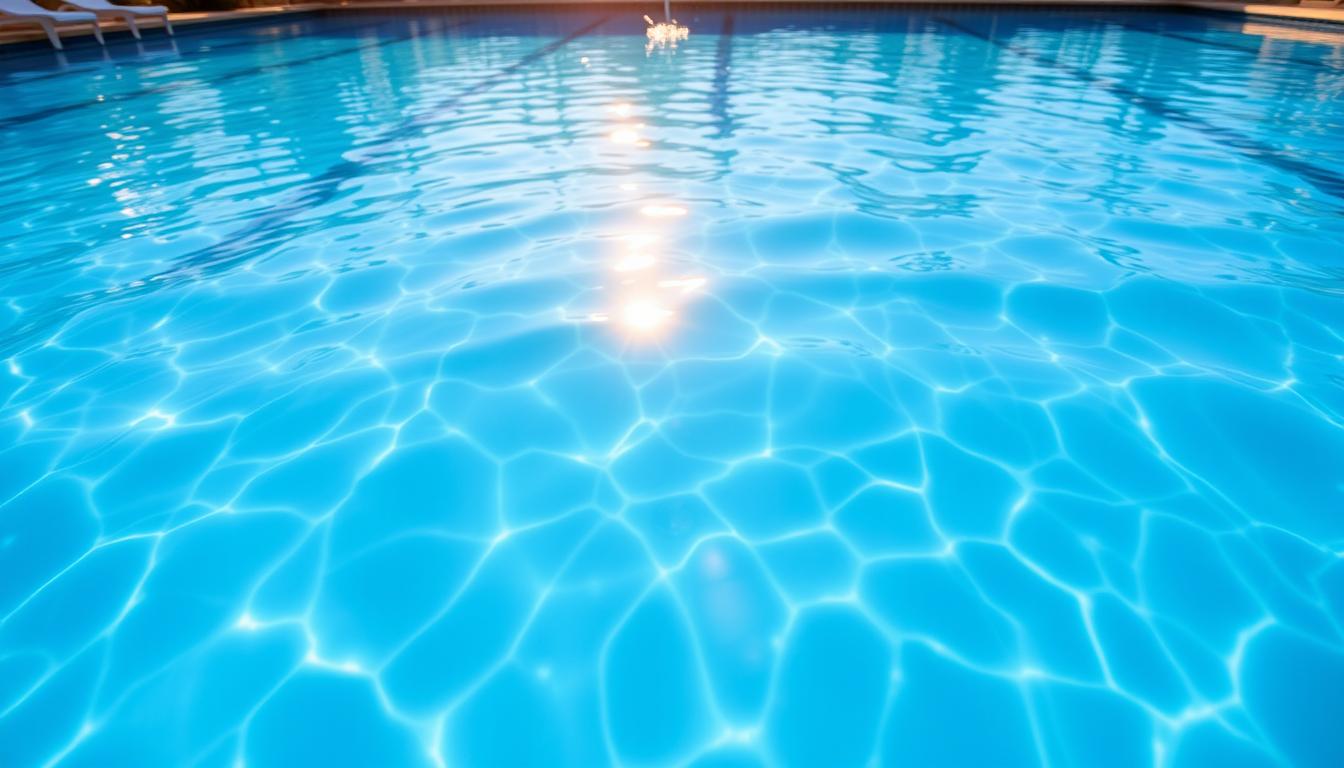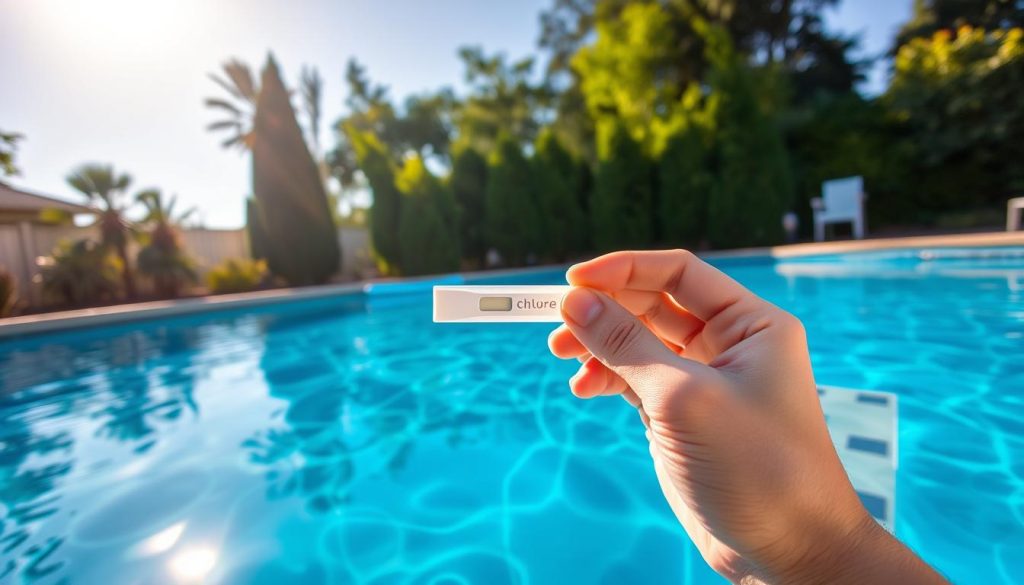
It’s a scorching summer day, and you’re eager to cool off in your pool. But you just added chlorine. Pool owners know the importance of proper chemical safety for a clean swimming environment.
Knowing how long to wait after adding chlorine is crucial. This helps avoid potential health risks when swimming.
Chlorine keeps pool water free from harmful bacteria and algae. It’s essential for a sanitary pool. However, swimming too soon after adding chlorine can be dangerous.
It may lead to skin and eye irritation. Respiratory issues and digestive problems are also possible. Understanding wait times and proper maintenance is key to safe swimming.
We’ll explore factors affecting chlorine dissipation time. We’ll provide guidelines for safe swimming after chlorination. You’ll also learn valuable tips on testing pH and chlorine levels.
By the end, you’ll know how long to wait after adding chlorine. You’ll also understand how to maintain a clean and safe pool environment.
Understanding Pool Shock and Chlorination
Pool maintenance is crucial for safe swimming. Chlorination is key to eliminating harmful bacteria and algae. Let’s explore pool shock and its role in keeping your pool clean.
What is Pool Shock?
Pool shock is a concentrated form of chlorine or non-chlorine alternatives. It quickly raises free chlorine levels in your pool. Free chlorine is the amount available to sanitize water and destroy contaminants.
The most common type is calcium hypochlorite, a fast-dissolving granular substance. Other forms include chlorinated isocyanurates, which provide a more stable chlorine source.
Purpose of Shocking a Pool
Shocking a pool raises free chlorine levels to destroy bacteria and algae. This process is called breakpoint chlorination. It typically requires raising chlorine levels to 10 times the normal dose.
Shocking is vital after heavy use, rainfall, or when you notice algae growth. Regular shocking helps maintain a clean swimming environment. Shock weekly for heavily used pools or every two weeks for less used ones.
Chemicals Used in Pool Shock
Calcium hypochlorite is the most common pool shock chemical. It contains about 65% available chlorine and dissolves quickly. Chlorinated isocyanurates are another option for pool shock.
These compounds provide stable chlorine and resist UV light breakdown. They’re ideal for outdoor pools. Always follow the manufacturer’s instructions and safety precautions when using pool shock products.
| Chemical | Available Chlorine | Ideal Usage |
|---|---|---|
| Calcium Hypochlorite | 65% | Weekly or bi-weekly shocking |
| Trichloroisocyanuric Acid | 90% | Outdoor pools, stabilized chlorine |
| Potassium Dichloroisocyanurate | 55% | Outdoor pools, stabilized chlorine |
Understanding pool shock ensures a clean, safe swimming environment. Always test water chemistry before and after shocking. Allow time for chlorine levels to normalize before swimming.
Recommended Wait Times After Chlorination
Pool chlorination requires a waiting period for safety. This ensures stable chlorine levels before swimming. Let’s explore guidelines, testing, and factors affecting wait times.

General Guidelines for Swimming After Shocking
Wait times vary based on chlorine type and pool size. Generally, wait an hour after adding chlorine. For chlorine shocks, a 24-hour wait is best.
Here are guidelines for different chlorine types:
- Chlorine Tablets: Swim after 15-30 minutes. Always check the product label.
- Liquid Chlorine: Usually safe to swim after 15-30 minutes.
- Chlorine Shock: Wait at least 24 hours before swimming.
Testing pH and Chlorine Levels
Regular testing of pH and chlorine levels is crucial. Aim for 1-3 ppm chlorine and 7.4-7.6 pH. Test weekly or more often for heavily used pools.
Chlorine levels should be confirmed to be under 5 ppm using a test strip before swimming to prevent skin and eye irritation.
Factors Affecting Wait Times
Several factors influence chlorination wait times:
- Pool Size: Larger pools may need longer for even chlorine distribution.
- Chlorine Concentration: Higher levels may require longer waits to prevent irritation.
- Water Temperature: Warmer water can speed up chlorine dissipation.
- Sunlight Exposure: UV rays break down chlorine faster.
| Chlorine Type | Recommended Wait Time |
|---|---|
| Chlorine Tablets | 15-30 minutes |
| Liquid Chlorine | 15-30 minutes |
| Chlorine Shock | 24 hours |
Understanding wait times and testing ensures safe swimming. Consider all factors for a fun pool experience.
Potential Risks of Swimming Too Soon
Swimming in a recently shocked pool can be dangerous due to high chlorine levels. Exposure can cause eye irritation, skin burns, and breathing problems. Safety precautions are crucial to protect swimmers from these potential risks.
Eye and Skin Irritation
High chlorine levels can cause eye redness, itching, and burning sensations. This may lead to discomfort and temporary vision issues. Chlorine rash can develop on the skin, causing red and itchy patches.
To avoid these problems, wait until chlorine levels stabilize before swimming. This ensures a safer and more enjoyable experience for everyone.
Respiratory Issues
Breathing in chlorine fumes can cause respiratory problems, especially for those with asthma or allergies. Symptoms include coughing, wheezing, and shortness of breath. Severe cases may damage the mouth, throat, and lungs.
Ensure proper ventilation around the pool area. Avoid swimming if you smell a strong chlorine odor.
Digestive Problems
Swallowing pool water with high chlorine levels can cause nausea, vomiting, and abdominal pain. Extreme cases may result in organ damage or low blood pressure. Avoid ingesting pool water.
Encourage children to take frequent breaks. This allows them to use the restroom and stay hydrated.
When to Seek Medical Attention
Seek medical help if you experience severe symptoms after swimming in a shocked pool. Watch for difficulty breathing, severe skin burns, or intense stomach pain. Other warning signs include persistent vomiting or vision loss.
For chemical burns, rinse the affected area with cool water. Then seek professional treatment. Always test chlorine levels before swimming to ensure safety.







